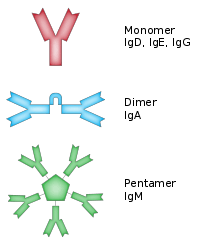Immunoglobulin D

Immunoglobulin D (IgD) is an antibody isotype that makes up about 1% of proteins in the plasma membranes of immature B-lymphocytes where it is usually coexpressed with another cell surface antibody called IgM. IgD is also produced in a secreted form that is found in very small amounts in blood serum, representing 0.25% of immunoglobulins in serum. Relative molecular mass and half-life of sIgD is 185 kDa and 2.8 days, respectively.[1] Secreted IgD is produced as a monomeric antibody with two heavy chains of the delta (δ) class, and two Ig light chains.
Function
IgD's function has always been a puzzle in immunology since its discovery in 1964. IgD is present in species from cartilaginous fish to human (probably with the exception of birds).[2] This nearly ubiquitous appearance in species with an adaptive immune system demonstrates that IgD is as ancient as IgM and suggests the notion that IgD has important immunological functions.
In B cells, IgD's function is to signal the B cells to be activated. By being activated, they are ready to take part in the defense of the body in the immune system. During B-cell differentiation, IgM is the exclusive isotype expressed by immature B cells. IgD starts to be expressed when the B-cell exits the bone marrow to populate peripheral lymphoid tissues. When a B-cell reaches its mature state, it co-expresses both IgM and IgD. It is not well understood whether IgM and IgD antibodies are functionally different on B cells. Cδ knockout mice (mice that have been genetically altered so that they do not produce IgD) have no major B-cell intrinsic defects.[3][4] IgD may have some role in allergic reactions.
Recently, IgD was found to bind to basophils and mast cells and activate these cells to produce antimicrobial factors to participate in respiratory immune defense in humans.[5] It also stimulates basophils to release B-cell homeostatic factors. This is consistent with the reduction in the number of peripheral B cells, reduced serum IgE level and defective primary IgG1 response in IgD knockout mice.
Method of coexpression
In the human Heavy-Chain Locus, 3' of the V-D-J cassette is a series of C (for constant) genes, each conferring an Ig isotype. The Cμ (IgM) gene is 3' and closest to the V-D-J cassette, with the Cδ gene appearing 3' to Cμ.
A Primary mRNA transcript will contain the transcribed V-D-J cassette, and the Cμ and Cδ genes, with introns in between them.
Alternative splicing can then occur, causing a selection of either Cμ or Cδ to appear on the functional mRNA (μ mRNA and δ mRNA respectively). Alternative splicing is thought to be possible due to two polyadenylation sites, one appearing between the Cμ and Cδ, and the other 3' of Cδ (polyadenylation in the latter site would cause Cμ to be spliced away along with the intron). The precise mechanism of how the polyadenylation site is chosen remains unclear.
The resulting functional mRNA will have the V-D-J and C regions contiguous, and its translation will generate either a μ heavy chain or δ heavy chain. The heavy chains then couple with either κ or λ light chains to create the final IgM or IgD antibody.
Zinc finger protein 318 (ZFP318) has a role in the promotion of IgD expression and controlling the alternative splicing of the long pre-mRNA.[6] In immature B cells that mainly express the μ transcript, there is no ZFP318 expression, but in mature B cells with dual IgM and IgD expression, both δ and μ transcript is made and ZFP318 is expressed.[6] Enders et al. (2014)[7] found in mice that null mutations in ZFP318 resulted in no IgD expression.
External links
- Immunoglobulin D at the US National Library of Medicine Medical Subject Headings (MeSH)
References
- ↑ Rogentine GN, Rowe DS, Bradley J, Waldmann TA, Fahey JL (1966). "Metabolism of human immunoglobulin D (IgD)" (PDF). J. Clin. Invest. 45 (9): 1467–78. doi:10.1172/JCI105454. PMC 292826
 . PMID 5919348.
. PMID 5919348. - ↑ Ohta, Yuko; Martin Flajnik (2006-07-11). "IgD, like IgM, is a primordial immunoglobulin class perpetuated in most jawed vertebrates". Proceedings of the National Academy of Sciences. 103 (28): 10723–10728. doi:10.1073/pnas.0601407103. PMC 1636022
 . PMID 16818885. Retrieved 2009-10-02.
. PMID 16818885. Retrieved 2009-10-02.
- ↑ Edholm ES, Bengten E, Wilson M (2011). "Insights into the function of IgD". Dev. Comp. Immunol. 35 (12): 1309–16. doi:10.1016/j.dci.2011.03.002. PMID 21414345.
- ↑ Nitschke L, Kosco MH, Köhler G, Lamers MC (1993). "Immunoglobulin D-deficient mice can mount normal immune responses to thymus-independent and -dependent antigens". Proc. Natl. Acad. Sci. U.S.A. 90 (5): 1887–91. doi:10.1073/pnas.90.5.1887. PMC 45985
 . PMID 8446604.
. PMID 8446604. - ↑ Chen, Kang; Xu, Weifeng; Wilson, Melanie; He, Bing; Miller, Norman W; Bengtén, Eva; Edholm, Eva-Stina; Santini, Paul A; et al. (2009). "Immunoglobulin D enhances immune surveillance by activating antimicrobial, proinflammatory and B cell–stimulating programs in basophils". Nature Immunology. 10 (8): 889–898. doi:10.1038/ni.1748. PMC 2785232
 . PMID 19561614.
. PMID 19561614. - 1 2 Murphy, K; Weaver, C (2016). Janeway's Immunobiology. New York, NY: Garland Science/Taylor and Francis. p. 195. ISBN 9780815345053.
- ↑ Enders, A., Short, A., Miosge, L., Bergmann, H., Sontani, Y., Bertram, E., Whittle, B., Balakishnan, B., Yoshida, K., Sjollema, G., Field, M., Andrews, T., Hagiwara, H. and Goodnow, C. (2014). "Zinc-finger protein ZFP318 is essential for expression of IgD, the alternatively spliced Igh product made by mature B lymphocytes.". Proceedings of the National Academy of Sciences. 111 (12): 4513–4518. doi:10.1073/pnas.1402739111. PMID 24616512.